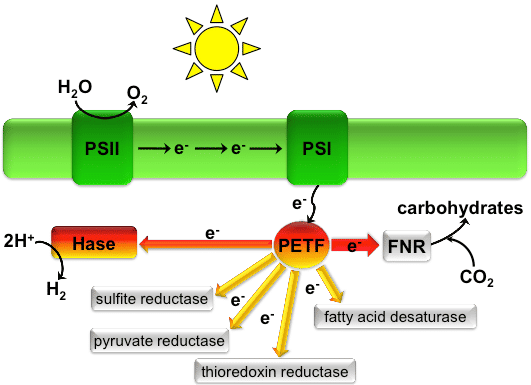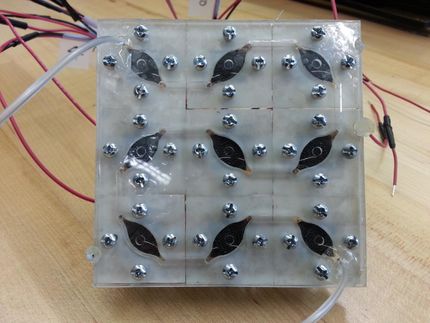Efficient production of hydrogen by algae
Advertisement
microalgae need only sunlight and water for the production of hydrogen. However, in order to make hydrogen production by microalgae economically feasible their efficiency has to be increased by 1-2 orders of magnitude. In the current issue of Energy and Environmental Science scientists from the AG Photobiotechnology of the Ruhr University Bochum and the Max Planck Institutes in Mülheim present how an improvement in efficiency can be achieved.

Electrontransfer in the alga C. reinhardtii, that leads to the production of hydrogen or other substances. Hase = Hydrogenase
© MPI CEC / RUB
Microalgae use light-energy to extract electrons from water during photosynthesis. Most of these electrons are transported by a small, iron-containing protein, the ferredoxin PETF, to the protein ferredoxin-NADP+-oxidoreductase (FNR), which feeds the electrons into the production chain of carbohydrates. PETF passes only a small fraction of the electrons to other proteins like the Hydrogenase. This protein is a very powerful enzyme, whose amino acid chain harbours a unique six-iron cluster, in which electrons (e-) are transferred to protons (H+) to produce hydrogen (H2).
Using nuclear magnetic resonance spectroscopy (NMR) the scientists investigated in great detail which amino acids of PETF interact with Hydrogenase and which with FNR. Thereby they identified two amino acids of PETF with negatively charged side chains that are ex-clusively important for binding FNR. The directed genetic modification of exactly those two residues to amino acids with uncharged side chains led to an increased production of hydrogen. Together with further modifications of the FNR this resulted in a five-fold increased rate for hydrogen production.
The knowledge-based change of electron transfer pathways has the potential to make further enhancements of hydrogen production possible. The efficiency necessary for an economic application of biological hydrogen production can probably be achieved by the combination of different modifications. Thus, the presented results are important for the development of an environmentally friendly, regenerative energy supply that does not depend on expensive and rare noble metals.
Original publication
Other news from the department science

Get the chemical industry in your inbox
By submitting this form you agree that LUMITOS AG will send you the newsletter(s) selected above by email. Your data will not be passed on to third parties. Your data will be stored and processed in accordance with our data protection regulations. LUMITOS may contact you by email for the purpose of advertising or market and opinion surveys. You can revoke your consent at any time without giving reasons to LUMITOS AG, Ernst-Augustin-Str. 2, 12489 Berlin, Germany or by e-mail at revoke@lumitos.com with effect for the future. In addition, each email contains a link to unsubscribe from the corresponding newsletter.
Most read news
More news from our other portals
See the theme worlds for related content
Topic World Spectroscopy
Investigation with spectroscopy gives us unique insights into the composition and structure of materials. From UV-Vis spectroscopy to infrared and Raman spectroscopy to fluorescence and atomic absorption spectroscopy, spectroscopy offers us a wide range of analytical techniques to precisely characterize substances. Immerse yourself in the fascinating world of spectroscopy!

Topic World Spectroscopy
Investigation with spectroscopy gives us unique insights into the composition and structure of materials. From UV-Vis spectroscopy to infrared and Raman spectroscopy to fluorescence and atomic absorption spectroscopy, spectroscopy offers us a wide range of analytical techniques to precisely characterize substances. Immerse yourself in the fascinating world of spectroscopy!
Topic world Synthesis
Chemical synthesis is at the heart of modern chemistry and enables the targeted production of molecules with specific properties. By combining starting materials in defined reaction conditions, chemists can create a wide range of compounds, from simple molecules to complex active ingredients.

Topic world Synthesis
Chemical synthesis is at the heart of modern chemistry and enables the targeted production of molecules with specific properties. By combining starting materials in defined reaction conditions, chemists can create a wide range of compounds, from simple molecules to complex active ingredients.


























































